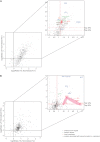The proteomic investigation of chromatin functional domains reveals novel synergisms among distinct heterochromatin components
- PMID: 23319141
- PMCID: PMC3591667
- DOI: 10.1074/mcp.M112.024307
The proteomic investigation of chromatin functional domains reveals novel synergisms among distinct heterochromatin components
Abstract
Chromatin is a highly dynamic, well-structured nucleoprotein complex of DNA and proteins that controls virtually all DNA transactions. Chromatin dynamicity is regulated at specific loci by the presence of various associated proteins, histones, post-translational modifications, histone variants, and DNA methylation. Until now the characterization of the proteomic component of chromatin domains has been held back by the challenge of enriching distinguishable, homogeneous regions for subsequent mass spectrometry analysis. Here we describe a modified protocol for chromatin immunoprecipitation combined with quantitative proteomics based on stable isotope labeling by amino acids in cell culture to identify known and novel histone modifications, variants, and complexes that specifically associate with silent and active chromatin domains. Our chromatin proteomics strategy revealed unique functional interactions among various chromatin modifiers, suggesting new regulatory pathways, such as a heterochromatin-specific modulation of DNA damage response involving H2A.X and WICH, both enriched in silent domains. Chromatin proteomics expands the arsenal of tools for deciphering how all the distinct protein components act together to enforce a given region-specific chromatin status.
Figures








Similar articles
-
The ChroP approach combines ChIP and mass spectrometry to dissect locus-specific proteomic landscapes of chromatin.J Vis Exp. 2014 Apr 11;(86):51220. doi: 10.3791/51220. J Vis Exp. 2014. PMID: 24747196 Free PMC article.
-
Maintenance of silent chromatin through replication requires SWI/SNF-like chromatin remodeler SMARCAD1.Mol Cell. 2011 May 6;42(3):285-96. doi: 10.1016/j.molcel.2011.02.036. Mol Cell. 2011. PMID: 21549307
-
Native Chromatin Proteomics (N-ChroP) to Characterize Histone Post-translational Modification (PTM) Combinatorics at Distinct Genomic Regions.Methods Mol Biol. 2021;2351:251-274. doi: 10.1007/978-1-0716-1597-3_14. Methods Mol Biol. 2021. PMID: 34382194
-
Biochemical systems approaches for the analysis of histone modification readout.Biochim Biophys Acta. 2014 Aug;1839(8):657-68. doi: 10.1016/j.bbagrm.2014.03.008. Epub 2014 Mar 27. Biochim Biophys Acta. 2014. PMID: 24681439 Review.
-
Chatting histone modifications in mammals.Brief Funct Genomics. 2010 Dec;9(5-6):429-43. doi: 10.1093/bfgp/elq024. Brief Funct Genomics. 2010. PMID: 21266346 Free PMC article. Review.
Cited by
-
Targeting the scaffolding role of LSD1 (KDM1A) poises acute myeloid leukemia cells for retinoic acid-induced differentiation.Sci Adv. 2020 Apr 8;6(15):eaax2746. doi: 10.1126/sciadv.aax2746. eCollection 2020 Apr. Sci Adv. 2020. PMID: 32284990 Free PMC article.
-
Multi-layered chromatin proteomics identifies cell vulnerabilities in DNA repair.Nucleic Acids Res. 2023 Jan 25;51(2):687-711. doi: 10.1093/nar/gkac1264. Nucleic Acids Res. 2023. PMID: 36629267 Free PMC article.
-
ChIP-less analysis of chromatin states.Epigenetics Chromatin. 2014 Apr 24;7:7. doi: 10.1186/1756-8935-7-7. eCollection 2014. Epigenetics Chromatin. 2014. PMID: 24872844 Free PMC article.
-
HyCCAPP as a tool to characterize promoter DNA-protein interactions in Saccharomyces cerevisiae.Genomics. 2016 Jun;107(6):267-73. doi: 10.1016/j.ygeno.2016.05.002. Epub 2016 May 13. Genomics. 2016. PMID: 27184763 Free PMC article.
-
The Proteomic Composition and Organization of Constitutive Heterochromatin in Mouse Tissues.Cells. 2024 Jan 11;13(2):139. doi: 10.3390/cells13020139. Cells. 2024. PMID: 38247831 Free PMC article.
References
-
- Kornberg R. D. (1974) Chromatin structure: a repeating unit of histones and DNA. Science 184, 868–871 - PubMed
-
- Luger K., Mader A. W., Richmond R. K., Sargent D. F., Richmond T. J. (1997) Crystal structure of the nucleosome core particle at 2.8 A resolution. Nature 389, 251–260 - PubMed
-
- Waddington C. H. (2011) The epigenotype. 1942. Int. J. Epidemiol. 41, 10–13 - PubMed
Publication types
MeSH terms
Substances
LinkOut - more resources
Full Text Sources
Other Literature Sources

